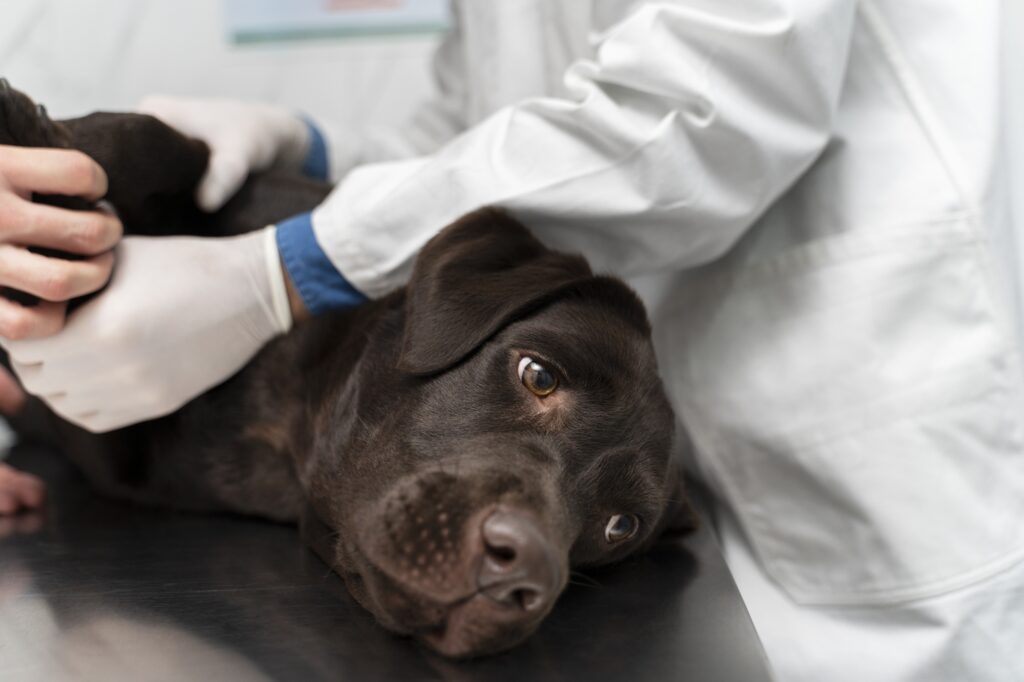
Contents
A bee or wasp sting can be more than just a minor inconvenience for pets—it can lead to severe allergic reactions, pain, and even dangerous complications. As much as we try to protect our pets from the outdoors, curious animals are often exposed to insects like bees and wasps, especially during the warmer months. Whether your pet is stung while playing outside or investigating a buzzing insect, it’s important to know what steps to take to help your pet.
In this blog, we’ll discuss how to identify a bee or wasp sting, what to do immediately after your pet is stung, and when to seek emergency pet care for a more serious allergic reaction.
Understanding the Risks of Bee and Wasp Stings
Both bees and wasps are common insects that can pose a risk to your pet, especially if they are provoked. While most pets only experience mild symptoms like swelling or irritation, some pets may have severe reactions that require immediate medical attention.
- Bee Stings: When a bee stings a pet, it leaves behind a stinger, which continues to release venom into the body. This can lead to pain, swelling, and irritation at the sting site.
- Wasp Stings: Unlike bees, wasps do not leave their stingers behind, so they can sting multiple times. Wasp stings can also cause intense pain, swelling, and allergic reactions in pets.
While most pets can handle a single sting without major issues, repeated stings or allergic reactions can lead to serious complications. Some pets may also have more severe reactions due to their size, breed, or health condition.
Symptoms of a Bee or Wasp Sting in Pets
The symptoms of a bee or wasp sting can vary depending on how your pet reacts to the venom. Most pets experience mild to moderate reactions, but others may have more severe symptoms. Here are the key signs to look for:
- Swelling and Redness
The most common symptom of a bee or wasp sting is localized swelling around the sting site. You may notice a bump on your pet’s skin, which may be red or inflamed. If the sting is on the face, the swelling can be more pronounced, especially around the mouth, eyes, or nose.
- Pain and Discomfort
Pets may express their discomfort by whining, limping, or showing signs of pain when the sting site is touched. They may also try to scratch or bite at the area to alleviate the irritation.
- Excessive Drooling or Licking
If your pet is in pain, they may start drooling excessively or licking the area where they were stung. This is a common response to discomfort or irritation.
- Itching and Scratching
Some pets experience intense itching at the site of the sting, causing them to scratch or rub the area repeatedly. If they manage to break the skin, it could lead to infection. - Pawing at the Face or Mouth
If the sting is in or near the mouth or face, your pet may paw at their face, attempting to relieve the discomfort. - Difficulty Breathing
In severe cases, particularly if your pet is having an allergic reaction, you may notice signs of respiratory distress, such as panting, rapid breathing, or wheezing. - Swelling of the Throat or Tongue
If the sting causes a severe allergic reaction, your pet may experience swelling of the throat or tongue, which can interfere with breathing. This is an emergency situation that requires immediate veterinary attention. - Lethargy or Weakness
If your pet is feeling unwell due to the sting or an allergic reaction, they may become unusually lethargic or weak. This could be a sign of a more severe reaction to the venom.
What to Do Immediately After a Bee or Wasp Sting
If your pet is stung by a bee or wasp, it’s important to act quickly to reduce their discomfort and prevent further complications. Here are the steps you should take:
- Remove the Stinger (If It’s a Bee Sting)
If your pet has been stung by a bee, check to see if the stinger is still embedded in their skin. Bee stingers can continue to release venom, so it’s important to remove it as quickly as possible. Use a flat-edged object, like a credit card, to scrape the stinger out. Avoid pinching the stinger, as this can push more venom into the wound. - Clean the Sting Site
Gently clean the area around the sting with warm water and mild soap to remove any dirt or debris. Avoid using harsh chemicals, as these can irritate the skin further. - Apply a Cold Compress
To reduce swelling and provide relief, apply a cold compress or ice pack wrapped in a towel to the sting site. Hold it there for 10-15 minutes at a time, taking breaks in between. Be careful not to apply the ice directly to the skin, as this can cause frostbite. - Monitor for Symptoms
After the initial treatment, carefully monitor your pet for any signs of a severe allergic reaction, such as swelling of the throat, difficulty breathing, or lethargy. If any of these symptoms occur, it’s critical to seek emergency care for pets immediately. - Do Not Give Human Medications
Avoid giving your pet any over-the-counter medications, such as Benadryl, without first consulting your vet. Some human medications can be toxic to pets, and the correct dosage must be determined by a professional. - Prevent Further Scratching
If your pet is pawing at the sting site, consider using an Elizabethan collar (cone) to prevent further irritation and to stop them from making the injury worse.
When to Seek Emergency Care for Pets
Most pets will experience mild reactions to bee or wasp stings that can be managed at home. However, if your pet shows any of the following signs, it’s time to seek emergency care for pets immediately:
- Difficulty Breathing
If your pet is having trouble breathing, this could be a sign of an allergic reaction or swelling in the airway. Immediate treatment is necessary to prevent suffocation. - Severe Swelling
If the swelling is spreading rapidly or affecting the face, neck, or throat, seek emergency help immediately. Swelling in these areas can obstruct the airway and cause breathing problems. - Loss of Consciousness or Seizures
If your pet loses consciousness, goes into shock, or begins seizing, you must get to the vet immediately. These are signs of a severe allergic reaction or toxicity. - Multiple Stings
If your pet has been stung multiple times, the venom can build up, potentially leading to more severe reactions. In such cases, it’s important to get your pet to an emergency clinic. - Unusual Behavior or Weakness
If your pet becomes unusually lethargic or weak, it may indicate a severe reaction. Seek veterinary care to ensure your pet gets the necessary treatment.
Conclusion
Bee and wasp stings can be painful and potentially dangerous for pets, especially if they experience an allergic reaction. By acting quickly to remove the stinger, clean the area, and monitor for symptoms, you can help your pet recover faster and prevent complications. If your pet shows any signs of a severe reaction, such as difficulty breathing or excessive swelling, don’t wait—get them to an emergency pet clinic immediately.
At North MS Pet Emergency, we are here to provide expert care for pets with bee or wasp stings and other emergency health issues. Our team is ready to help when your pet needs immediate treatment.
Contact Us Now for immediate care, or visit us for emergency care for pets after hours.




